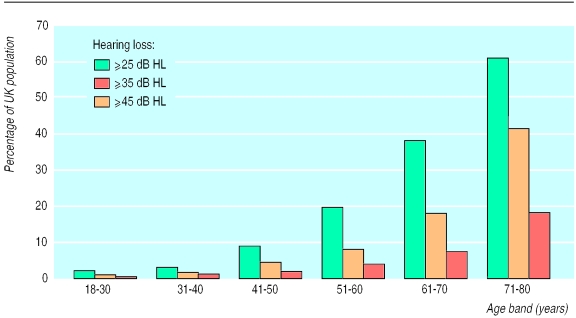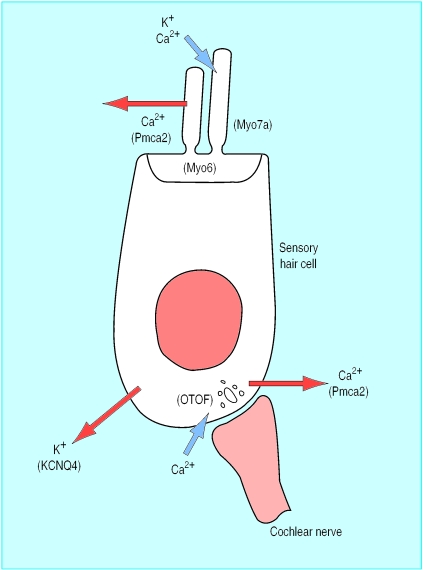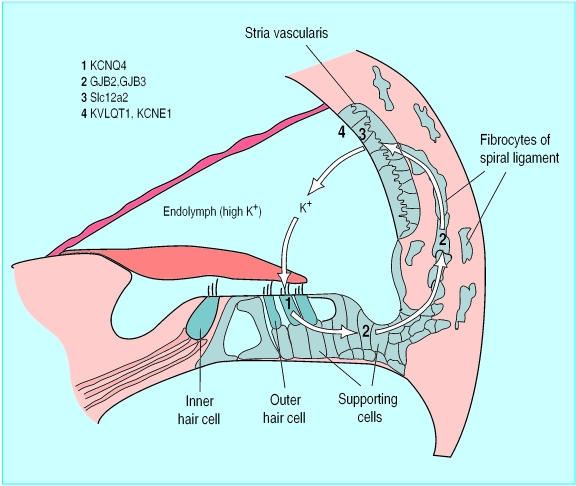Hearing impairment is the most prevalent sensory deficit in the human population, with about 1 in 800 children born with a serious hearing impairment and more than 60% of people aged over 70 suffering sufficient hearing loss to benefit from a hearing aid (fig 1).1 Sign language may be useful for a tiny proportion of those affected, those with profound childhood deafness, but for the vast majority of people with impaired hearing this is not an option, and social isolation combined with economic and educational disadvantage is the common outcome. Cochlear implants have improved the hearing of many adults and children with profound deafness, and surgery can relieve middle ear problems such as otosclerosis (which affects only a small proportion of hearing impaired people), but there is no medical (as opposed to surgical) treatment available for most people with sensorineural hearing impairment. In this article, I summarise recent progress in understanding the biology of deafness and outline some possibilities for alternative treatments that may be available in the future.
Figure 1.
Progression of hearing impairment with age. Values are percentages in each age band of UK population with hearing impairment at the level indicated. Data from Davis 19951
Methods
The views expressed in this article have been developed over many years and are based on my personal experience of research in the subject, discussions with scientists and clinicians as well as with people affected by deafness, and extensive reading of the literature, only a tiny proportion of which has been cited here.
The role of genetics in deafness
Our growing awareness and understanding of the role of genetics in deafness has given us hope that medical treatments may one day be developed. It is generally thought that about half the cases of childhood deafness are due to a single gene mutation, while the rest are due to environmental causes. However, it seems highly likely that genetics and the environment interact even when there seems to be a clear environmental determinant, as individuals may be genetically predisposed to hearing loss induced by noise, drugs, or infection. Indeed, one particular mutation (A1555G in the mitochondrial 12S rRNA gene) is known to predispose carriers to deafness induced by aminoglycoside antibiotics.2 We now know of several genes which, when mutated, can lead to progressive hearing loss starting in adulthood. It is only a small step to imagine that these same genes might in other people carry mutations with milder effects, leading to the progressive hearing loss that is so often suffered by elderly people but is not recognised as having a genetic basis.3
Predicted developments
Universal neonatal screening for early detection of hearing impairment to allow early intervention (screening imminent, medical intervention in 10-20 years)
Cheap diagnostic tools based on DNA chips to allow rapid detection of commonest gene mutations associated with deafness in either children or adults (in 5-10 years)
Detection of DNA sequence variants that predispose people to environmental damage to their hearing to allow an informed choice of lifestyle (in 5-10 years)
Gene therapy or drug treatments to halt or reverse progression of hearing loss, for children as well as elderly people (in 10-20 years)
Treatments to stimulate regeneration of sensory structures of the ear (possibly in combination with gene therapy if there is a genetic cause for the deafness) for people with profound deafness (in 10-20 years)
Identifying genes involved in deafness
The past few years have seen dramatic progress in our knowledge of genes involved in deafness. Over 50 different chromosomal loci have been associated with the most common type of deafness, non-syndromic deafness (deafness with no obvious associated features). In the past two years alone no fewer than 14 of these genes have been identified (that is, the DNA sequence established and mutations found in deaf individuals).4 The molecules encoded by these genes range from channel components and motor molecules to extracellular matrix components and transcription factors.5 It is not surprising to find such a wide range of molecules involved in deafness because the ear is so complex a structure that there must be many ways of interfering with its development or function.5 There are clearly many more genes to be found that are associated with non-syndromic deafness, possibly over 100.
Even more genes are known to be involved in syndromic deafness (deafness as part of a defined set of anomalies).5 There are over 400 distinct syndromes that include hearing impairment as a feature,6 and the genes for a couple of dozen of these have been identified.4,5 Again, a wide range of proteins are produced by these genes.5
Additional deafness genes have been discovered through studies in animal models, notably mice. Such genes are obvious candidates to consider for potential involvement in human genetic deafness, and, irrespective of whether they are involved in human deafness, they tell us more about normal auditory function.
What clinical conclusions can we draw so far?
Several general features are emerging from research into the molecular basis of deafness. Firstly, deafness is highly heterogeneous; many different genes can be involved in causing the same clinical picture. For example, any one of 10 different genes can be involved in causing Usher syndrome (childhood deafness with progressive retinitis pigmentosa), and there are dozens of genes that can underlie non-syndromic deafness.4 This complicates genetic counselling considerably.
Secondly, some genes can be involved with different types of deafness, such as both dominant and recessive deafness, both syndromic and non-syndromic deafness, or both congenital and late onset progressive deafness. This observation gives us clues to potential avenues for treatments (see below), but it also means that simplistic divisions of deafness into early or late onset, syndromic or non-syndromic, and so forth, will not necessarily reflect the biology underpinning the deafness.
Thirdly, it is often difficult to give a prognosis based on mutation analysis because even when two people carry an identical mutation they may have very different hearing abilities.7 This means that we cannot give concrete predictions of the hearing status of unborn children, at least not until we understand much more about the reasons for the variability.
A single gene, GJB2, which encodes the connexin 26 molecule, has been found to play a major role in genetic deafness in many Western populations.8,9 The gene is small and relatively easy to screen for mutations, and there is one very common mutation in the population. These findings make testing for mutations in the gene in affected families, or even screening the general population, a realistic proposition in the short term and have brought to the forefront the debate about the ethical implications of such a possibility. No laboratory in Britain presently offers a screening service for GJB2 mutations.
What have we learnt about auditory function?
The sensory hair cell in the cochlea is the site of auditory transduction, where the mechanical energy of sound vibration is converted into an action potential in the cochlear nerve. Several of the molecules involved in genetic deafness are located in sensory hair cells and must therefore have a vital role in hair cell function (fig 2). During transduction, potassium floods into the hair cell, depolarising the cell and triggering an action potential in the associated cochlear neurones. This potassium is recycled, and deafness can result from mutations affecting key steps in this process (fig 3). Connexin 26, which is often involved in human non-syndromic deafness, is a component of the gap junctions between cells involved in potassium recycling. The observation that mutations in many different genes involved in potassium recycling can lead to deafness emphasises the importance of maintaining the correct ionic balance within the cochlea.
Figure 2.
Diagram of sensory hair cell and some of the molecules associated with deafness. Sound causes deflection of stereocilia (“hairs”) at top of cell, opening transduction channels in cell membrane and allowing potassium (K+) and calcium (Ca2+) ions to enter and depolarise cell, which triggers release of neurotransmitters at synapse at base of cell and initiates action potential in cochlear nerve. Three motor molecules—encoded by genes Myo6, Myo7a, and Myo15—maintain organisation of stereocilia10,11,12; calcium and potassium entering cell are removed by calcium pump encoded by Pmca213 and potassium channel encoded by KCNQ414 respectively; and otoferlin (encoded by OTOF) may help control neurotransmitter release at synapse15
Figure 3.
Key aspects of potassium recycling in cochlear duct. Potassium entering stimulated hair cells may be removed via potassium channel encoded by KCNQ414 and taken up by cells below. It is then passed through network of gap junctions linking adjacent cells around cochlear duct to stria vascularis on side wall of duct. Connexin 26, connexin 31, and connexin 30 (encoded by genes GJB2, GJB3, and GJB6) are components of these gap junctions.8,9,16,17 Potassium is then pumped into strial cells with help of Na-K-Cl cotransporter (encoded by Slc12a2),18,19 from which it is passed back into endolymph via ion channels formed from products of KVLQT1 and KCNE1.20,21 Mutations in any of these genes can cause deafness in humans or mice, indicating that correct ionic milieu of sensory hair cells is essential for their continued function
How can this information lead to new treatments?
Early diagnosis
It may one day be possible to reverse certain types of defect that affect the early development of the auditory system, but it is much easier to imagine that we could stop or reverse a progressive deterioration in auditory function because we know that the cochlea in such cases was once able to function adequately. A prerequisite for treatment is early and accurate diagnosis, giving a chance for intervention before the degenerative process has progressed too far. Diagnosis would involve screening an individual's DNA for mutations known to be associated with enhanced susceptibility to hearing loss. This could be done at any age. Appropriate treatment might include changes to lifestyle (such as avoidance of loud environments or ototoxic drugs), immunisation if susceptibility to deafness induced by an infection is suspected, or drug treatments to minimise the effects of a mutation in causing progressive hearing loss (see below).
What about childhood deafness? Some childhood hearing loss may be progressive during the first few months or years of life. Early diagnosis of hearing impairment in children would be essential if medical interventions were to stand a good chance of preserving some hearing ability, so the development of a national programme of screening neonatal hearing (presently under consideration by the National Screening Committee) would play a key role.22 Any babies with hearing impairment could be tested for the most common mutations associated with deafness. Intervention would depend on us having a much greater understanding of the likelihood of developing a serious hearing impairment than we presently have, so that a realistic prognosis could be provided to aid a family's decision.
Gene therapy
The most obvious intervention for a genetic defect is gene therapy, which in its simplest form means introducing a normal version of the defective gene into the appropriate cell and hoping that the cell will use it. The practical aspects of introducing large stretches of DNA into mature cells are being developed in systems where the affected cells are far more accessible than those of the inner ear. Some work is being done on introducing genes into the inner ear, but there is a long way to go before this approach will be available.
Drug treatment
An alternative approach is based on drugs, which, by definition, are small molecules with ready access to the target cells. We may be able to exploit alternative pathways to carry out the task that is affected by a mutation. For example, another connexin may be capable of substituting for connexin 26 in forming gap junctions, but its gene may not normally be expressed in the cochlea. A drug might therefore be developed to activate expression of the alternative connexin gene in the cells needing to form gap junctions. Clues about which alternative pathways might be worth exploiting will come from investigations of interacting genes.5
Hair cell regeneration
Hair cells in the cochlea are very vulnerable to disruption of their homeostasis and tend to die if they cannot function normally, as in much genetic deafness. Hair cell death resulting from environmental insults can also be a cause of hearing loss. Once dead, hair cells are not naturally replaced. One approach to treating deafness would be to trigger regeneration of cochlear hair cells, so there has been considerable interest in defining the cascade of gene activity that determines the developmental fate of cells in the cochlea and the differentiation of some into sensory hair cells. If we understood this process, we might be able to trigger new hair cells to develop from other cell types. However, there is no point in stimulating the regeneration of hair cells that are unable to function because of a genetic defect, and so accurate diagnosis of the cause of hearing impairment will be vital for this approach to succeed. For those with genetic deafness, perhaps hair cell regeneration combined with gene therapy to replace the defective gene might be considered.
Conclusion
Hearing loss is often thought of as an inevitable part of growing older, often with no obvious cause. However, we are beginning to appreciate that this may not be true and that we may one day be able to determine the cause and treat the underlying pathology in our ageing population as well as in children.
Acknowledgments
I thank Ralph Holme, Adrian Davis, and Julian Dacie for their comments on the manuscript.
Footnotes
Competing interests: None declared.
References
- 1.Davis AC. Hearing in adults. London: Whurr; 1995. [Google Scholar]
- 2.Estivill X, Govea N, Barceló A, Perelló E, Badenas C, Romero E, et al. Familial progressive sensorineural deafness is mainly due to the mtDNA A1555G mutation and is enhanced by treatment with aminoglycosides. Am J Hum Genet. 1998;62:27–35. doi: 10.1086/301676. [DOI] [PMC free article] [PubMed] [Google Scholar]
- 3.Steel KP. Progress in progressive deafness. Science. 1998;279:1870–1871. doi: 10.1126/science.279.5358.1870. [DOI] [PubMed] [Google Scholar]
- 4.Van Camp G, Smith RJH. Hereditary Hearing Loss Homepage. http://dnalab-www.uia.ac.be/dnalab/hhh (accessed 30 Nov 1999).
- 5.Steel KP, Bussoli TJ. Deafness genes: expressions of surprise. Trends Genetics. 1999;15:207–211. doi: 10.1016/s0168-9525(99)01753-9. [DOI] [PubMed] [Google Scholar]
- 6.OMIM, Online Mendelian Inheritance in Man. Center for Medical Genetics, Johns Hopkins University (Baltimore, MD) and National Center for Biotechnology Information, National Library of Medicine (Bethesda, MD), 1999. www.ncbi.nlm.nih.gov/omim/ (accessed 30 Nov 1999).
- 7.Denoyelle F, Marlin S, Weil D, Moatti L, Chauvin P, Garabédian E, et al. Clinical features of the prevalent form of childhood deafness, DFNB1, due to a connexin-26 gene defect: implications for genetic counselling. Lancet. 1999;353:1298–1303. doi: 10.1016/S0140-6736(98)11071-1. [DOI] [PubMed] [Google Scholar]
- 8.Denoyelle F, Weil D, Maw MA, Wilcox SA, Lench NJ, Allen-Powell DR, et al. Prelingual deafness: high prevalence of a 30delG mutation in the connexin 26 gene. Hum Mol Genet. 1997;6:2173–2177. doi: 10.1093/hmg/6.12.2173. [DOI] [PubMed] [Google Scholar]
- 9.Estivill X, Fortino P, Surrey S, Rabionet R, Melchionda S, D'Agruma L, et al. Connexin-26 mutations in sporadic and inherited sensorineural deafness. Lancet. 1998;351:394–398. doi: 10.1016/S0140-6736(97)11124-2. [DOI] [PubMed] [Google Scholar]
- 10.Self T, Mahony M, Fleming J, Walsh J, Brown SDM, Steel KP. Shaker-1 mutations reveal roles for myosin VIIA in both development and function of cochlear hair cells. Development. 1998;125:557–566. doi: 10.1242/dev.125.4.557. [DOI] [PubMed] [Google Scholar]
- 11.Probst FJ, Fridell RA, Raphael Y, Saunders TL, Wang A, Liang Y, et al. Correction of deafness in shaker2 mice by an unconventional myosin in a BAC transgene. Science. 1998;280:1444–1447. doi: 10.1126/science.280.5368.1444. [DOI] [PubMed] [Google Scholar]
- 12.Street VA, McKee-Johnson JW, Fonseca RC, Tempel BL, Noben-Trauth K. Mutations in a plasma membrane Ca2+-ATPase gene cause deafness in deafwaddler mice. Nature Genet. 1998;19:390–394. doi: 10.1038/1284. [DOI] [PubMed] [Google Scholar]
- 13.Kubisch C, Schroeder BC, Friedrich T, Lütjohann B, El-Amraoui A, Marlin S, et al. KCNQ4, a novel potassium channel expressed in sensory outer hair cells, is mutated in dominant deafness. Cell. 1999;96:437–446. doi: 10.1016/s0092-8674(00)80556-5. [DOI] [PubMed] [Google Scholar]
- 14.Yasunaga S, Grati M, Cohen-Salmon M, El-Amraoui A, Mustapha M, Salem N, et al. A mutation in OTOF, encoding otoferlin, a FER-1-like protein, causes DFNB9, a non-syndromic form of deafness. Nature Genet. 1999;21:363–369. doi: 10.1038/7693. [DOI] [PubMed] [Google Scholar]
- 15.Xia J, Liu C, Tang B, Pan Q, Huang L, Dai H, et al. Mutations in the gene encoding gap junction protein β-3 associated with autosomal dominant hearing impairment. Nature Genet. 1998;20:370–373. doi: 10.1038/3845. [DOI] [PubMed] [Google Scholar]
- 16.Grifa A, Wagner CA, D'Ambrosio L, Melchionda S, Bernardi F, Lopez-Bigas N, et al. Mutations in GJB6 cause nonsyndromic autosomal dominant deafness at DFNA3 locus. Nature Genetics. 1999;23:16–18. doi: 10.1038/12612. [DOI] [PubMed] [Google Scholar]
- 17.Delpire E, Lu J, England R, Dull C, Thorne T. Deafness and imbalance associated with inactivation of the secretary Na-K-2Cl co-transporter. Nature Genetics. 1999;22:192–195. doi: 10.1038/9713. [DOI] [PubMed] [Google Scholar]
- 18.Dixon MJ, Gazzard J, Chaudhry SS, Sampson N, Schulte BA, Steel KP. Mutation of the Na-K-Cl co-transporter gene Slc12a2 results in deafness in mice. Hum Mol Genet. 1999;8:1579–1584. doi: 10.1093/hmg/8.8.1579. [DOI] [PubMed] [Google Scholar]
- 19.Tyson J, Tranebjærg L, Bellman S, Wren C, Taylor JFN, Bathen J, et al. IsK and KvLQT1: mutation in either of the two subunits of the slow component of the delayed rectifier potassium channel can cause Jervell and Lange-Nielsen syndrome. Hum Mol Genet. 1997;6:2179–2185. doi: 10.1093/hmg/6.12.2179. [DOI] [PubMed] [Google Scholar]
- 20.Vetter DE, Mann JR, Wangemann P, Liu J, McLaughlin KJ, Lesage F, et al. Inner ear defects induced by null mutation of the isk gene. Neuron. 1996;17:1251–1264. doi: 10.1016/s0896-6273(00)80255-x. [DOI] [PubMed] [Google Scholar]
- 21.Self T, Sobe T, Copeland NG, Jenkins NA, Avraham KB, Steel KP. Role of myosin VI in the differentiation of cochlear hair cells. Dev Biol. 1999;214:331–341. doi: 10.1006/dbio.1999.9424. [DOI] [PubMed] [Google Scholar]
- 22.Davis AC, Bamford J, Wilson I, Ramkalawan T, Forshaw M, Wright S. A critical review of the role of neonatal hearing screening in the detection of congenital hearing impairment. Health Technol Assessment 1997;1(10). [PubMed]





